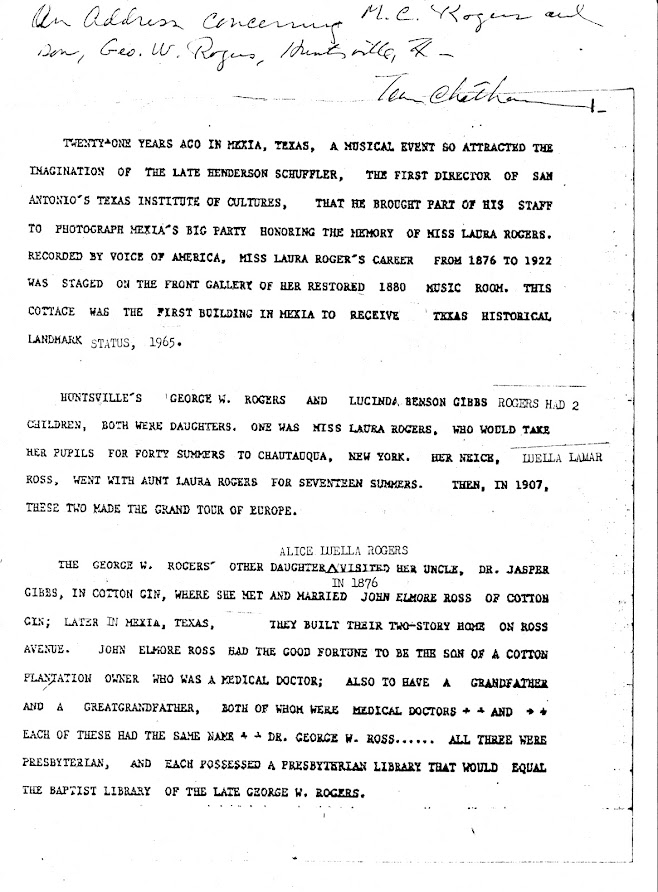Sepia Saturday is focused on music this month...so I am reminded of my music teacher Great Grand Aunt Laura Rogers of Mexia, Texas.
Here's the Historic Marker for Laura Terrissa Rogers, a music teacher in Mexia, Texas from 1880-1920. (Text is given below so you don't have to strain your eyes)

"Miss Rogers Music Room, Built opposite public school, for Laura T. Rogers, who (1880-1920) taught piano and choral music from 7 am to 7pm 6 days a week, 8 months in year. Had 4 pianos used all day, 8 pupils often played in unison. Auditorium with overflow seating in the yard, staged recitals and dramas. A church organist/choir director 35 years Miss Rogers kindled cultural interests in pupils of two generations. Recorded Texas Historic Landmark, 1965. (Note, the historic marker gives the wrong year for her death which was in 1922.)
She lived with her married sister, Alice Luella Rogers Ross, and remained single all her life. But she was a very active woman...and much admired by her relatives and pupils.
Laura's sister Luella married John Ross when she was 22, and moved to Mexia TX, where he first he worked as a store clerk, and Laura apparently lived with them early on. She is on the census with the Ross family continually until her death in 1922.
Great Great Aunts Laura and Luella's brother was my direct ancestor, my father's grandfather, William Sandford Rogers.
Aunt Laura would have been living with her sister's family when my grandfather, George E. Rogers Sr, and his little sister Annie were under the guardianship of the Ross family following their father's death. Their mother, Betty, must not have been able to care for them, nor could anyone in her family, because the Ross family were made their guardians, with my grandfather just two years old, and his sister Annie just one. I didn't realize their mother had continued living in another city until I read a census in Galveston which included her and her 2 children, later in their childhoods.
John Ross was the manager of the water works of Mexia, Texas as of the 1900 census. And his sister-in-law, Laura, in 1900 at age 48 she is listed as unable to read, but can write. By the 1910 census after the death of her husband, L. Ella (Luella) Ross (56) was head of household, and Laura would have been 57 and is listed as blind.
GG Aunt Laura had been the second oldest child born to my GGG grandparents, George and Lucinda Rogers of Huntsville TX, but both Laura and her one-year younger sister (Alice) Luella were both born in Mount Lebanon, Bienville Parish, LA, where their mother's family lived. My great great grandfather William Samuel (W. Sam) Rogers had been the oldest child, born in Huntsville TX. Their mother, Lucinda Gibbs Rogers had a brother who was a doctor in Mount Lebanon, LA, which could have been the reason she went there to have her babies. With two younger brothers who died in their first years, perhaps Lucinda had trouble with carrying her children. They had one younger brother, George W. II, who lived to be 18 years old, born in Mount Lebanon.
Laura Terrissa Rogers is buried in the Mexia City Cemetery, as well as her sister Laura Rogers Ross and her husband John Elmore Ross.
An article in the Mexia Daily News on June 25, 1965, describes as the second place to visit on Mexia's Tour is Laura T. Rogers' Music Room.
This text (below) was given as an address during an event to honor of Laura Terrissa Rogers at her "Music Room" in Mexia Texas. The date attached in Ancestry is 1886...which was early in Miss Rogers' career. If it was 1986 that's after the death in 1956 of Thomas Chatham who wrote the note at the top) So at this point I only know in 1965 there was a celebration. When the one was that is in the first paragraph of the following text, I'm not sure.
It also includes some interesting information about my great grandfather, George W. Rogers, and his father M.C. Rogers. The only thing I've found that is inaccurate is the statement that George W. Rogers was "only parent to Luella and Laura Rogers." He also was the father of William Sandford Rogers, (1850-1879) my Great Grandfather!
Thomas Chatham, who signed the note at the top of page one, was son of Mrs. Lamar Ross Chatham, daughter of John Elmore Ross and Luella Rogers Ross. So Laura was his mother's auntie.
AND an update regarding that first paragraph of the San Antonio's Texas Institute of Cultures...I found it is still in existence but struggling to continue due to funding shortages. I emailed them with that first paragraph, and they called me back on Wed. Jan 10, 2024 and said they had no records of the event I was referring to. I asked if they had records from 1965...thinking that wasn't all that long ago, but she continued to just say they had no records. She referred me to the San Antonio library's genealogy reference section. I said I should also try the Mexia Library and Historical Societies, if they exist. So that was a dead end for now!
Sharing with Sepia Saturday this week.
















.jpg)